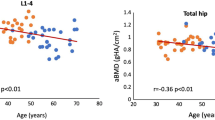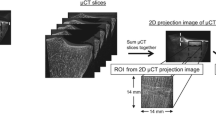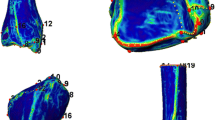Abstract:
Measurement of microstructural parameters of trabecular bone noninvasively in vivo is possible with high-resolution magnetic resonance (MR) imaging. These measurements may prove useful in the determination of bone strength and fracture risk, but must be related to other measures of bone properties. In this study in vivo MR imaging was used to derive trabecular bone structure measures and combined with micro-finite element analysis (μFE) to determine the effects of trabecular bone microarchitecture on bone mechanical properties in the distal radius. The subjects were studied in two groups: (I) postmenopausal women with normal bone mineral density (BMD) (n= 22, mean age 58 ± 7 years) and (II) postmenopausal women with spine or femur BMD −1 SD to −2.5 SD below young normal (n= 37, mean age 62 ± 11 years). MR images of the distal radius were obtained at 1.5 T, and measures such as apparent trabecular bone volume fraction (App BV/TV), spacing, number and thickness (App TbSp, TbN, TbTh) were derived in regions of interest extending from the joint line to the radial shaft. The high-resolution images were also used in a micro-finite element model to derive the directional Young’s moduli (E1, E2 and E3), shear moduli (G12, G23 and G13) and anisotropy ratios such as E1/E3. BMD at the distal radius, lumbar spine and hip were assessed using dual-energy X-ray absorptiometry (DXA). Bone formation was assessed by serum osteocalcin and bone resorption by serum type I collagen C-terminal telopeptide breakdown products (serum CTX) and urinary CTX biochemical markers. The trabecular architecture displayed considerable anisotropy. Measures of BMD such as the ultradistal radial BMD were lower in the osteopenic group (p<0.01). Biochemical markers between the two groups were comparable in value and showed no significant difference between the two groups. App BV/TV, TbTh and TbN were higher, and App TbSp lower, in the normal group than the osteopenic group. All three directional measures of elastic and shear moduli were lower in the osteopenic group compared with the normal group. Anisotropy of trabecular bone microarchitecture, as measured by the ratios of the mean intercept length (MIL) values (MIL1/MIL3, etc.), and the anisotropy in elastic modulus (E1/E3, etc.), were greater in the osteopenic group compared with the normal group. The correlations between the measures of architecture and moduli are higher than those between elastic moduli and BMD. Stepwise multiple regression analysis showed that while App BV/TV is highly correlated with the mechanical properties, additional structural measures do contribute to the improved prediction of the mechanical measures. This study demonstrates the feasibility and potential of using MR imaging with μFE modeling in vivo in the study of osteoporosis.
Similar content being viewed by others
Author information
Authors and Affiliations
Additional information
Received: 13 December 2000 / Accepted: 30 May 2001
Rights and permissions
About this article
Cite this article
Newitt, D., Majumdar, S., van Rietbergen, B. et al. In Vivo Assessment of Architecture and Micro-Finite Element Analysis Derived Indices of Mechanical Properties of Trabecular Bone in the Radius. Osteoporos Int 13, 6–17 (2002). https://doi.org/10.1007/s198-002-8332-0
Issue Date:
DOI: https://doi.org/10.1007/s198-002-8332-0




